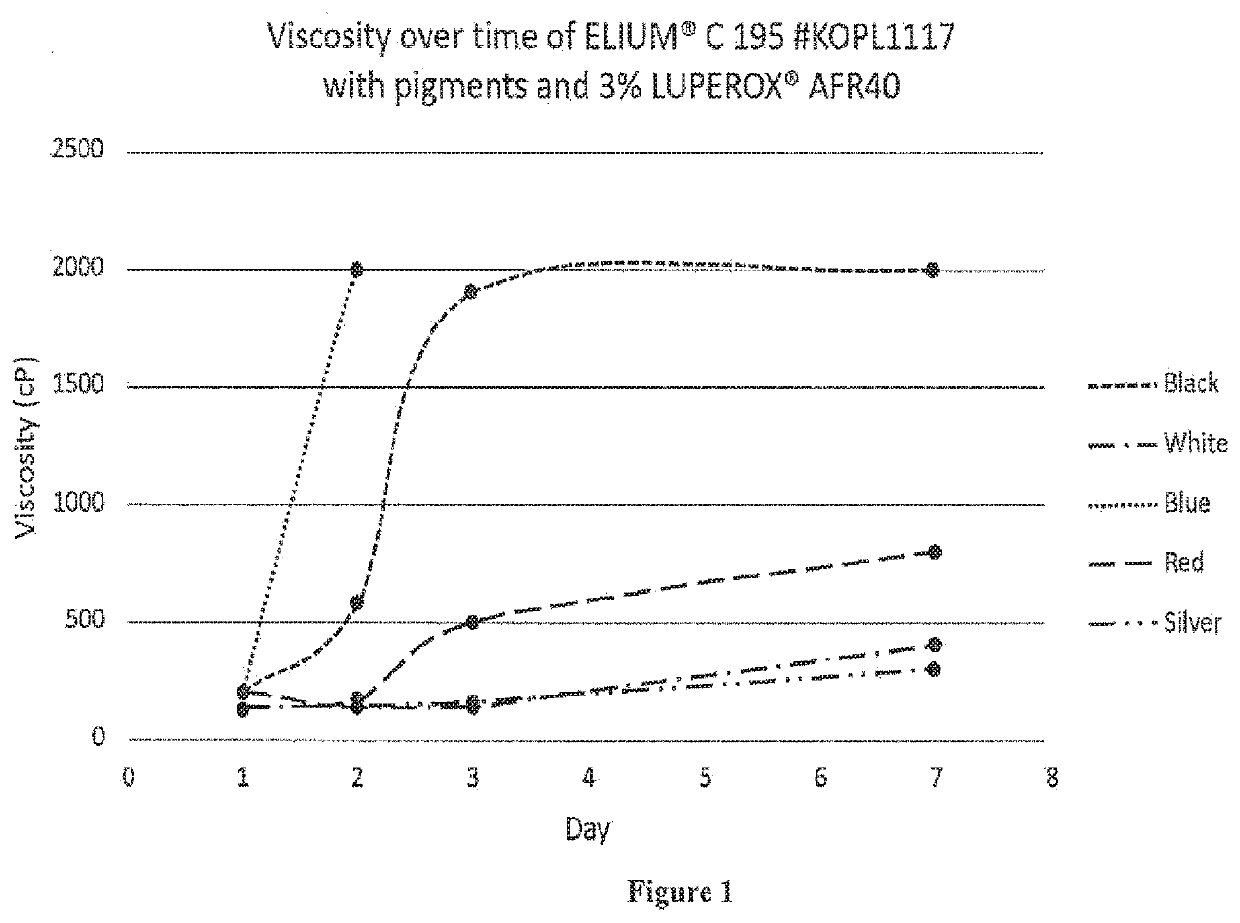Acrylic composites with improved surface properties
a composite material and surface technology, applied in the field of composite materials, can solve the problems of difficult recycling of thermoset composite materials, inability to easily shape the matrix in other forms, and rigidity of thermoset polymer matrix, so as to improve the uv or thermal stability of the composite material, and satisfy mechanical and surface properties
- Summary
- Abstract
- Description
- Claims
- Application Information
AI Technical Summary
Benefits of technology
Problems solved by technology
Method used
Image
Examples
example 1
UV Absorbers
[0137]In order to improve the UV stability of a composite material with a polymeric thermoplastic (meth)acrylic matrix, two types of UV absorbers were incorporated into the liquid resin before initiators were added. This was accomplished by first creating a concentrate of said UV absorbers in MMA via shear stirring. This concentrate was added to the liquid composite resin, which comprises 20 wt % of PMMA with an MFI of 1.5 g / 10 min (according to ASTM D1238 measured at 230° C. / 3.8 kg) dissolved in 80% of MMA, at levels appropriate to achieve target formulation. The liquid syrup was then combined with glass fibers via vacuum infusion where a benzoyl peroxide initiator (3% Luperox® AFR 40) was used to cure the syrup at room temperature.
[0138]Tinuvin® P and Tinuvin® 360 were the two benzatriazole UV absorbers used. Resin formulations containing Tinuvin® P at 150 ppm and 700 ppm were used. A comparative example with no UV absorber was also fabricated and tested.
[0139]After ex...
example 2
Colorants
[0141]The effects of pigments on ELIUM® C195, was evaluated to measure the evolution of viscosity according to pigment color.
Samples:
[0142]1. ELIUM® C195, (20 wt % PMMA dissolved in 80 wt % MMA monomer)
[0143]2. ELIUM® C195 with Black pigment
[0144]3. ELIUM® C195 with White pigment
[0145]4. ELIUM® C195 with Blue pigment
[0146]5. ELIUM® C195 with Red pigment
[0147]6. ELIUM® C195 with Silver pigment
Experimental:
[0148]In an 8 oz glass jar, the appropriate amount of pigment (4 g or 1 g) was weighed using a pipette, and the respective quantity of ELIUM® C195 resin (93 g or 96 g) was added and the jar was capped. The material was stabilized at room temperature for at least 1 hour.
[0149]Then 3% (3 g) of Luperox® A75 initiator was added. The material was stirred for 5 minutes using a tongue depressor and a stopwatch was started as soon as the mixing begun. After approximately 30 seconds a thermocouple wire was placed into the solution and secured in place. Then the temperature and visco...
example 3
Infusion of Pigmented ELIUM® Liquid Resin
Pigmented RT150 Solution Formulation:
[0155]95% ELIUM® RT150 (20% P MMA dissolved in 80% MMA)
5% Green pigment (25% phthalocyanine green / 75% cellulose acetate butyrate)
Mixing Method:
[0156]Added 285 g of ELIUM® RT150 to 1000 m in a HDPE beaker[0157]Added 15 g of green “crumb” pigment[0158]Pigment coagulated[0159]Beaker was covered with aluminum foil to prevent MMA evaporation out of RT150[0160]Stirred with shear mixing head at 200 RPM for 1+ hours. Clumps of coagulated pigment still remained at the bottom of the beaker. Removed the clumps and reweighed resin—260 g. Added 7.8 g of or 3% Luperox® EZFlo and mixed with wooden stick until dissolved (˜30 seconds)
Pre-Prepared a 12″×10″ Laminate for Infusion on a Level Glass Mold Surface:
[0161]8 plies of plain weave Chomorat glass fiber mat[0162]Peel ply on top of the mat[0163]1405-B; LDPE Infusion Flow Media, Red[0164]Stretchlon 800 PE bag[0165]Grey vacuum tape
Infusion of Laminate Panel:
[0166]Set vacuu...
PUM
| Property | Measurement | Unit |
|---|---|---|
| Fraction | aaaaa | aaaaa |
| Fraction | aaaaa | aaaaa |
| Fraction | aaaaa | aaaaa |
Abstract
Description
Claims
Application Information
 Login to View More
Login to View More - R&D
- Intellectual Property
- Life Sciences
- Materials
- Tech Scout
- Unparalleled Data Quality
- Higher Quality Content
- 60% Fewer Hallucinations
Browse by: Latest US Patents, China's latest patents, Technical Efficacy Thesaurus, Application Domain, Technology Topic, Popular Technical Reports.
© 2025 PatSnap. All rights reserved.Legal|Privacy policy|Modern Slavery Act Transparency Statement|Sitemap|About US| Contact US: help@patsnap.com

